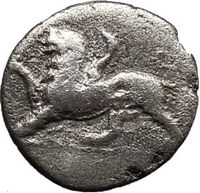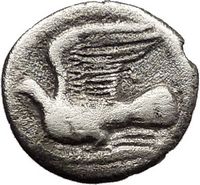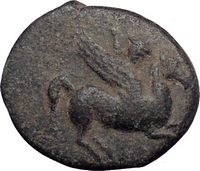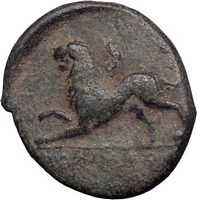Chimera
the Ancient Greek Monster
History and Authentic Ancient Greek Coins Available to Buy for Coin
Collecting or Investment
Buy authentic ancient coins of Chimera - the Ancient Greek Monster
Get incredible value, with the beautiful, custom-made, full-color,
professionally researched certificate of authenticity, a $50-$100 value
all in itself, absolutely free, no matter what coin
you buy. A fun way to learn about and preserve history for future
generations. Ancient coins make a great gift, investment
and collection all in one. Find out for yourself what over 10,000 other
satisfied customers say about their experience and
start your ancient coin collection today.
 
Example of Authentic Ancient
Coin of:
Greek city of Sikyon in Sikyonia
Silver Hemidrachm 15mm (2.31 grams) Struck 360-330 B.C.
Reference: Sear 2774
Chimera standing left; ΣΙ beneath.
Dove flying left.
 
Example of Authentic Ancient
Coin of:
Greek city of Leukas in Akarnania
Bronze 18mm (4.26 grams) Struck circa 350-250 B.C.
Reference: Sear 2287 var.; BMC 176, 47ff
Bellerophon riding right on Pegasus, thrusting spear.
Chimera at bay, left.
The Chimera (// or //,
also Chimaera, Chimæra; Greek:
Χίμαιρα Chímaira) was,
according to Greek
mythology, a monstrous fire-breathing female and male creature of Lycia in Asia
Minor, composed of the parts of three animals — a lion,
a snake and
a goat.
Usually depicted as a lion, with the head of a goat arising from its back, and a
tail that ended in a snake's head, the
Chimera was one of the offspring of Typhon and Echidna and
a sibling of such monsters as Cerberusand
the Lernaean
Hydra.
The term chimera has come to describe any mythical or fictional animal with
parts taken from various animals, or to describe anything perceived as wildly
imaginative or implausible.
Description
Homer's brief description in the Iliad is
the earliest surviving literary reference: "a thing of immortal make, not human,
lion-fronted and snake behind, a goat in the middle, and
snorting out the breath of the terrible flame of bright fire". Elsewhere
in the Iliad, Homer attributes
the rearing of Chimera to Amisodorus. Hesiod's Theogony follows
the Homeric description: he makes the Chimera the issue of Echidna: "She
was the mother of Chimaera who breathed raging fire, a creature fearful, great,
swift-footed and strong, who had three heads, one of a grim-eyed lion;
in her hinderpart, a dragon;
and in her middle, a goat,
breathing forth a fearful blast of blazing fire. Her did Pegasus and noble
Bellerophon slay" The
author of theBibliotheca concurs: descriptions
agree that she breathed fire.
The Chimera is generally considered to have been female (see the quotation from
Hesiod above) despite the mane adorning
its lion's
head, the inclusion of a close mane often was depicted on lionesses, but the
ears always were visible (that does not occur with depictions of male lions).
Sighting the Chimera was an omen of storms, shipwrecks,
and natural
disasters (particularly volcanoes).
While there are different genealogies,
in one version the Chimera mated with her brother Orthrus and
mothered the Sphinx and
the Nemean
lion (others have Orthrus and
their mother, Echidna, mating; most attribute all to Typhon and Echidna).
The Chimera finally was defeated by Bellerophon,
with the help of Pegasus,
at the command of King
Iobates of Lycia.
Since Pegasus could fly, Bellerophon shot the Chimera from the air, safe from
her heads and breath. A scholiast to
Homer adds that he finished her off by equipping his spear with a lump of lead
that melted when exposed to the Chimera's fiery breath and consequently killed
her, an image drawn from metalworking.
Robert Graves suggests, "The
Chimera was, apparently, a calendar-symbol of the tripartite year, of which the
seasonal emblems were lion, goat, and serpent."

Pebble mosaic depicting Bellerophon killing the Chimera, from Rhodesarchaeological
museum
The Chimera was situated in foreign Lycia, but
her representation in the arts was wholly Greek. An
autonomous tradition, one that did not rely on the written word, was represented
in the visual repertory of the Greek vase-painters. The Chimera first appears at
an early stage in the proto-Corinthian pottery-painters'
repertory, providing some of the earliest identifiable mythological scenes that
can be recognized in Greek
art. The Corinthian type is fixed, after some early hesitation, in the 670s
BC; the variations in the pictorial representations suggest to Marilyn Low
Schmitt a
multiple origin. The fascination with the monstrous devolved by the end of the
seventh century into a decorative Chimera-motif in Corinth, while
the motif of Bellerophon on Pegasus took on a separate existence alone. A
separate Attic tradition, where the goats breathe fire and the animal's rear is
serpent-like, begins with such confidence that Marilyn Low Schmitt is
convinced there must be unrecognized earlier local prototypes. Two vase-painters
employed the motif so consistently they are given the pseudonyms the Bellerophon
Painter and the Chimaera Painter. A fire-breathing lioness was one of the
earliest of solar and war deities in Ancient Egypt (representations from 3000
years prior to the Greek) and influences are feasible.
In Etruscan
civilization, the Chimera appears in the "Orientalizing" period that
precedes Etruscan Archaic art; that is to say, very early indeed. The Chimera
appears in Etruscan wall-paintings of the fourth century BC.
In Medieval
art, though the Chimera of Antiquity was forgotten, chimerical figures
appear as embodiments of the deceptive, even Satanic forces
of raw nature. Provided with a human face and a scaly tail, as in Dante's vision
of Geryon in Inferno xvii.7–17,
25–27, hybrid monsters, more akin to the Manticore of Pliny's
Natural History (viii.90),
provided iconic representations of hypocrisy and fraud well into the seventeenth
century, through an emblemmatic representation in Cesare
Ripa's Iconologia.
Classical sources
The myths of the Chimera can be found in Pseudo-Apollodorus' Bibliotheca (book
1), Homer's Iliad (book
6); Hyginus' Fabulae 57
and 151; Ovid's Metamorphoses (book
VI 339; IX 648); and Hesiod's Theogony 319ff.
Virgil, in the Aeneid (book
5) employs Chimaera for
the name of Gyas' gigantic
ship in the ship-race, with possible allegorical significance in contemporary
Roman politics.
Hypothesis about origin

The eternal fires of Chimera in Lycia where
the myth takes place
Main article: Mount
Chimaera
Pliny the Elder cited Ctesias and
quoted Photius identifying
the Chimera with an area of permanent gas vents which still can be found today
by hikers on the Lycian
Way in southwest Turkey.
Called in Turkish Yanartaş (flaming
rock), it consists of some two dozen vents in the ground, grouped in two patches
on the hillside above the Temple of Hephaestus about
3 km north of Çıralı,
near ancient Olympos,
in Lycia.
The vents emit burning methane thought
to be of metamorphic origin,
which in ancient times were landmarks by
which sailors could navigate.
The Neo-Hittite Chimera from Carchemish,
dated to 850–750 BC, which is now housed in the Museum
of Anatolian Civilizations no
doubt served as a basis for the Greek legend. It differs from the Greek version
in that while there are three heads, none of them is that of a goat, only a main
human head, a lion's head facing forward and placed on the chest of the lion's
body, and a snake's head placed at the end of the tail.
Use for
Chinese mythological creatures
Some western scholars of Chinese art, starting with Victor
Segalen, use the word "chimera" generically to refer to winged quadrupeds,
such as bixie, tianlu,
and even qilin.
See also
|